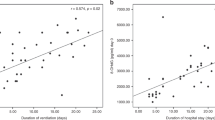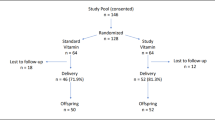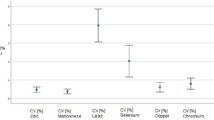Abstract
Objective: To determine the concentrations of the low molecular weight antioxidants urate, bilirubin, albumin and sulphydryl groups and to measure lipid peroxidation levels in pair-matched maternal and cord blood plasma.
Design: Venous blood plasma concentrations of urate, bilirubin, albumin and sulphydryls were determined in healthy pregnant women and in pair matched umbilical cords. The ability of maternal and cord plasma to withstand Cu2+-induced lipid peroxidation was assessed by measuring the production of thiobarbituric acid reactive substances (TBARS) over time in plasma incubated with Cu2+.
Subjects: Forty healthy women, between 10 and 20 weeks gestation, were recruited randomly from an antenatal clinic. Venous blood samples were obtained from the mothers at the recruitment stage and from the umbilical cords of their newborn after delivery.
Results: Urate, bilirubin and sulphydryls were present in significantly higher concentrations (P<0.001) in cord plasma than in maternal plasma. Albumin levels were similar in mothers and cords. Significantly lower levels (P=0.018) of TBARS were produced in cord plasma compared with maternal plasma following incubation with Cu2+. There were significant correlations between albumin and sulphydryl concentrations in maternal plasma (r 0.43, P=0.007) and between urate concentrations in maternal and cord plasma (r 0.37, P=0.026).
Conclusion: Urate, bilirubin and sulphydryls are present in significantly higher concentrations in cord blood than in maternal blood. The increased levels of these antioxidants in cord plasma may contribute to the increased resistance of cord plasma to Cu2+-induced lipid peroxidation.
Sponsorship: University College Cork, Ireland.
This is a preview of subscription content, access via your institution
Access options
Subscribe to this journal
Receive 12 print issues and online access
$259.00 per year
only $21.58 per issue
Buy this article
- Purchase on Springer Link
- Instant access to full article PDF
Prices may be subject to local taxes which are calculated during checkout
Similar content being viewed by others
Author information
Authors and Affiliations
Contributions
Guarantor: M Kiely
Contributors: M Kiely (Research Fellow, principal investigator and author, PA Morrissey (Professor, Head of Department, development of research project), PF Cogan (College Lecturer, recruitment of mothers, assessment of neonatal health), PJ Kearney (Professor, Head of Department, patient care, development of research project)
Rights and permissions
About this article
Cite this article
Kiely, M., Morrissey, P., Cogan, P. et al. Low molecular weight plasma antioxidants and lipid peroxidation in maternal and cord blood. Eur J Clin Nutr 53, 861–864 (1999). https://doi.org/10.1038/sj.ejcn.1600866
Received:
Revised:
Accepted:
Published:
Issue Date:
DOI: https://doi.org/10.1038/sj.ejcn.1600866



